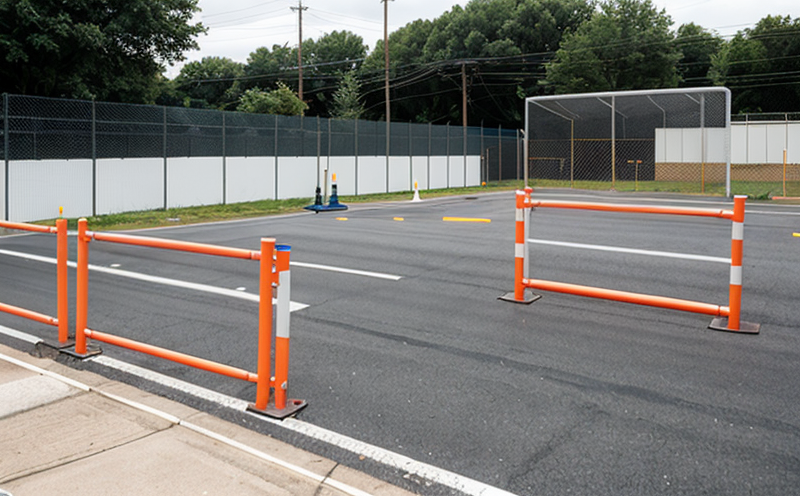EN 13178 Protective Barriers Against Flying Particles Testing
The EN 13178 standard provides comprehensive guidelines for testing protective barriers designed to shield workers from hazardous flying particles. This European Standard is crucial for ensuring the safety and effectiveness of such barriers across various industries, including construction, manufacturing, and maintenance.
Protective barriers are essential components in safeguarding personnel against risks associated with particulate matter, which can include dust, metal fragments, wood chips, or other airborne materials. These barriers must be designed to withstand impact from flying particles without compromising the safety of workers. The EN 13178 standard helps manufacturers and suppliers ensure their products meet stringent performance requirements.
The testing process involves subjecting a specimen of the protective barrier to controlled impact with various types of flying particles at specified velocities and angles. The primary objective is to evaluate the barrier's ability to prevent penetration by these particles while maintaining structural integrity. This ensures that workers remain protected from potential injuries resulting from direct contact with hazardous materials.
The testing procedure typically begins with selecting appropriate particle sizes, shapes, and velocities based on real-world scenarios where protective barriers are used. Specimens of the barrier material are then prepared according to detailed specifications outlined in EN 13178. Once ready, these specimens undergo impact tests using a specialized apparatus capable of simulating field conditions accurately.
During testing, the specimen is exposed to impacts from flying particles originating at different angles relative to its surface. The results are carefully recorded and analyzed to determine whether any penetration occurs through the barrier during each trial run. Acceptance criteria specify acceptable levels of particle transmission or penetration based on factors like particle size distribution, impact energy, and angle of incidence.
For instance, some particles may have higher kinetic energies due to their velocity combined with mass; thus, they require more robust barriers compared to lighter particles traveling at lower speeds. By adhering strictly to EN 13178 standards during development stages, manufacturers can produce reliable protective equipment that effectively protects workers from harmful exposures.
The importance of this testing cannot be overstated as it directly impacts both worker safety and compliance with international regulations. Non-compliance could lead to significant legal consequences for employers who fail to provide adequate protection against flying particles in their work environments.
Understanding the nuances involved in EN 13178 compliance helps quality managers, compliance officers, R&D engineers, and procurement teams make informed decisions about selecting suitable protective barriers. By ensuring adherence to this standard throughout product lifecycle management processes, organizations can enhance overall occupational safety practices within their facilities.
- Why is it important for companies operating in high-risk environments like construction sites?Companies in high-risk environments must comply with EN 13178 to safeguard workers from potential injuries caused by flying particles. Non-compliance can result in severe health implications and costly legal actions.
- What role does proper specimen preparation play in accurate testing results?Proper specimen preparation ensures that the test conditions accurately reflect real-world applications. Inadequate sample preparation could lead to inaccurate assessment of barrier performance, impacting both safety and regulatory compliance.
Why It Matters
The protection provided by EN 13178-compliant protective barriers is critical for ensuring worker safety in industries where flying particles pose significant risks. These particles can originate from various sources such as cutting tools, grinding operations, or even natural occurrences like dust storms.
In environments where workers are exposed to these hazards, using protective barriers that meet the stringent requirements set forth by EN 13178 becomes paramount. The standard ensures that barriers not only prevent penetration but also maintain structural integrity under stress conditions. This contributes significantly towards reducing accidents and injuries caused by direct contact with harmful materials.
From a broader perspective, compliance with EN 13178 fosters trust among employees regarding the reliability of safety measures implemented in their workplace. When organizations consistently demonstrate adherence to international standards like this one, they reinforce their commitment to occupational health and safety. This can lead to improved morale and productivity levels within teams.
Furthermore, meeting these stringent requirements helps businesses avoid costly penalties associated with non-compliance or accidents resulting from inadequate protection measures. By investing in EN 13178-compliant protective barriers, companies position themselves as leaders in safety innovation and best practice implementation.
In conclusion, the importance of EN 13178 testing cannot be overstated for maintaining a safe working environment across diverse industries. It serves as both a benchmark for quality assurance and a crucial step towards preventing serious injuries and fatalities linked to flying particles exposure.
Customer Impact and Satisfaction
- How does EN 13178 enhance customer confidence?Compliance with EN 13178 demonstrates a company’s commitment to providing high-quality, safe protective barriers. This enhances customer confidence by ensuring that the products meet stringent international standards.
- What role does accurate testing play in maintaining long-term relationships?Accurate and consistent testing results contribute to building trust between suppliers and customers. Reliable performance data helps establish a reputation for quality, fostering lasting business partnerships.
Environmental and Sustainability Contributions
The rigorous testing protocols prescribed by EN 13178 play a vital role in enhancing environmental sustainability. Ensuring that protective barriers are robust enough to protect workers against flying particles minimizes the likelihood of accidents, which can lead to waste generation due to improper disposal or cleanup efforts.
By selecting materials and designs that comply with EN 13178, manufacturers contribute positively towards reducing environmental impact. This includes minimizing unnecessary replacements caused by subpar products and promoting safer working practices overall.
Moreover, the emphasis on structural integrity helps extend the useful life of protective barriers, thereby reducing waste generation associated with frequent replacement cycles. Such measures not only benefit the immediate environment but also contribute to long-term sustainability goals set forth by organizations committed to greener operations.





